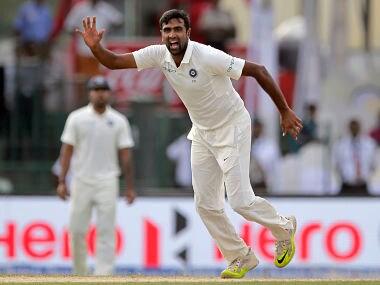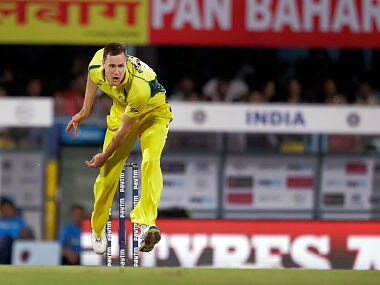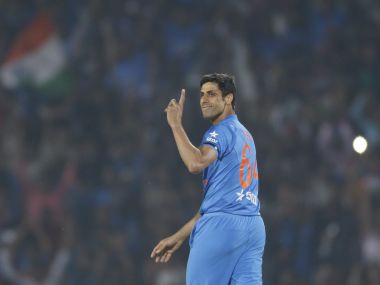India vs Australia: Playing Hardik Pandya at No 4 will allow hosts to explore possibility of 6-bowler attack
If and when that does happen, moving Pandya to No 4 in ODIs permanently will have ripples elsewhere
Chetan Narula, Oct, 12 2017
- Australia in India, 3 T20 International Series, 2017 IND Vs AUS Australia beat India by 8 wickets
- ICC World Cricket League Championship, 2015/17 PNG Vs SCO Papua New Guinea beat Scotland by 5 wickets
- Australia in India, 3 T20 International Series, 2017 IND Vs AUS India beat Australia by 9 wickets (D/L method)
- Pakistan and Sri Lanka in UAE, 2 Test Series, 2017 PAK Vs SL Sri Lanka beat Pakistan by 68 runs
- Bangladesh in South Africa, 2 Test Series, 2017 SA Vs BAN South Africa beat Bangladesh by an innings and 254 runs
- Pakistan and Sri Lanka in UAE, 5 ODI Series, 2017 PAK vs SL - Oct 13th, 2017, 04:30 PM IST
- Australia in India, 3 T20 International Series, 2017 IND vs AUS - Oct 13th, 2017, 07:00 PM IST
- Bangladesh in South Africa, 3 ODI Series, 2017 SA vs BAN - Oct 15th, 2017, 01:30 PM IST
- Pakistan and Sri Lanka in UAE, 5 ODI Series, 2017 PAK vs SL - Oct 16th, 2017, 04:30 PM IST
- Bangladesh in South Africa, 3 ODI Series, 2017 SA vs BAN - Oct 18th, 2017, 01:30 PM IST
| Rank | Team | Points | Rating |
|---|---|---|---|
| 1 | India | 4493 | 125 |
| 2 | South Africa | 3395 | 110 |
| 3 | England | 4497 | 105 |
| 4 | New Zealand | 3114 | 97 |
| 5 | Australia | 3294 | 97 |
| Rank | Team | Points | Rating |
|---|---|---|---|
| 1 | India | 5993 | 120 |
| 2 | South Africa | 5957 | 119 |
| 3 | Australia | 5948 | 114 |
| 4 | England | 6156 | 114 |
| 5 | New Zealand | 5123 | 111 |
| Rank | Team | Points | Rating |
|---|---|---|---|
| 1 | New Zealand | 1625 | 125 |
| 2 | England | 1962 | 123 |
| 3 | Pakistan | 2417 | 121 |
| 4 | West Indies | 2222 | 117 |
| 5 | India | 2183 | 115 |





There was a curious happenstance when India were reduced to 8/2 and 16/3 in the second T20I against Australia in Guwahati. First, Manish Pandey walked out to bat at No 4. Then, Kedar Jadhav came in at No 5. It just didn’t make any sense.
Of late, India have been experimenting a great deal with their middle order options. It has coincided with the big move to start early on the road to the 2019 World Cup, as KL Rahul came in at No 4 in Sri Lanka. Jadhav and Pandey also moved up and down the order depending on the situation, with even Virat Kohli relinquishing his No 3 spot from time-to-time on that tour.
Against Australia in the ODIs then, the team management went a step further. Hardik Pandya was sent out to attack the Australian spinners, and he used the long handle to brutal effect starting in Indore. So much so that Kohli and company began contemplating if this move made sense in the long term.
Hardik Pandya bats during the recently-concluded ODI series against Australia. AP
If and when that does happen, moving Pandya to No 4 in ODIs permanently will have ripples elsewhere. Jadhav and Pandey will be demoted and they will be asked to adapt to batting lower down the order, again. There will also be question marks over MS Dhoni’s optimal batting position — he is no longer the immaculate finisher he once was, and needs to bat no lower than No 5. But Pandya moving higher up means that Dhoni has to go back to No 6 again, and that doesn’t suit India’s limited overs plans anymore.
Most of all though India will be looking for a new finisher because Pandya’s training will have been undone. It was amply displayed in the fourth ODI at Bengaluru when Pandya misfired in the middle, and then the rest couldn’t finish the job. It pushes this move into the ambit of debate, and there is ample time to figure stuff out. At the same time however, Pandya’s elevation in the 50-over format does present another possible idea and it pertains to the shortest format.
The two pointers emerging from India’s loss in Guwahati were the lack of an enforcer in the middle order, and possibly the shortage of one full-time bowler. When both Pandey and Jadhav came out to bat ahead of Dhoni, it made for some bafflement. The situation asked for some stability, but given the T20 format, it also asked for someone who could take the attack to the opposition. Pandya was that man, and India missed a trick in not promoting him to No 4 in that last game.
This purported change in batting order in the shortest format — and Pandya’s elevation therein — provides a new dimension to the Indian lineup. It cannot be that the Men in Blue are no different in approach or personnel whether playing 50 overs or 20 overs. There is a similarity in the way ODIs and T20s turn out to be on parallel paths, albeit the speed of cricket is different.
Giving Pandya a permanent spot up the line-up — unlike in ODIs — thus mixes things up. It also gives the middle order more firepower in a format wherein they have often been lethargic. He can provide the impetus the Indian innings so badly misses on a regular basis, especially if the top-order fails to fire as per plan.
Additionally, it brings the bowling angle into play as well, the secondary point as aforementioned. A couple early wickets had given Kohli’s men a sniff in Guwahati, but they couldn’t push through and defend the lowly total because their second line of attack was found wanting.
Promoting Pandya up the order opens up the spot to play an extra full-time bowler, whether a spinner or pacer based on conditions. In Guwahati, it could have meant the possible inclusion of Ashish Nehra, and proper usage of dewy conditions wherein Bhuvneshwar Kumar and Jasprit Bumrah got good purchase. India sorely missed a third pace option as their leg spinners struggled and Pandya was rendered ineffective on account of his lack of pace and swing. Slower conditions would warrant an extra spinner. It might even allow the Indian team management to look at an alternate all-round option, picking someone from the IPL vastness next season around.
The underlying point is simple enough. India exhibited great adventurism during the ODI series against Australia, and even in Sri Lanka. But the same trait goes missing when it comes to T20s, wherein such risky escapades are a demand of the format. Giving Pandya a more elaborate role — even if to accelerate his ODI development — will only help achieve that in both the short and long terms.
Published Date:Oct 12, 2017
| Updated Date: Oct 12, 2017
Also See
India vs Australia: Ashish Nehra, Shikhar Dhawan recalled for T20 side, Ajinkya Rahane left out
India vs Australia: Visitors eye turnaround while hosts aim T20 series win as ACA-Barsapara stadium gears for debut
India vs Australia report card: Hardik Pandya scores full marks, Rohit Sharma shines for hosts